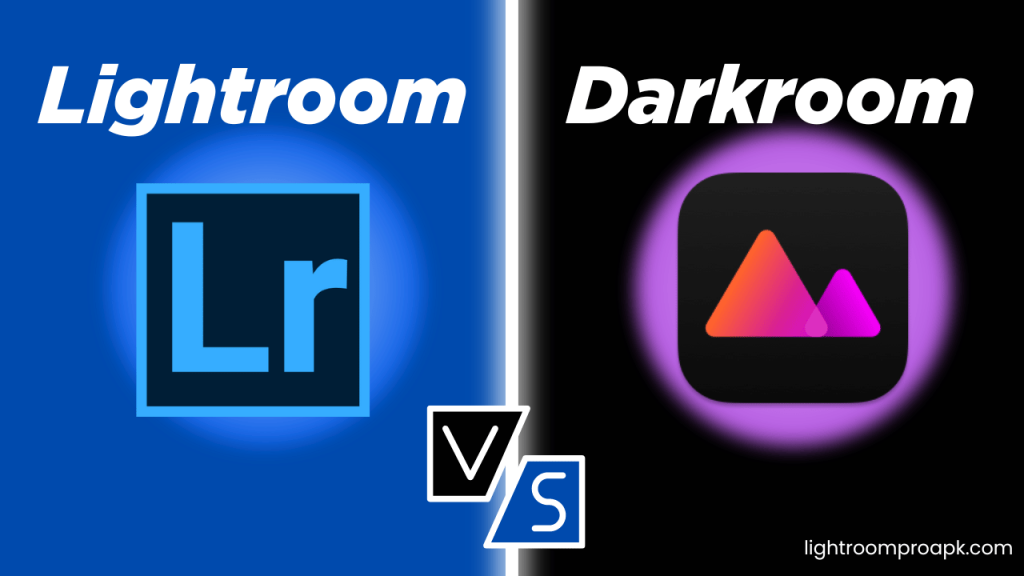Lightroom vs Darkroom: Which One is Best Editor 2025 ?

Nowadays, several people are searching for high-quality photo editing software to help with their projects or improve image quality. This article will compare Lightroom and Darkroom, highlighting their key features along with their pros and cons. Both software options are popular for photo editing and can be used to improve images for personal or professional projects. Properly using these tools can lead to impressive results.
You can also easily use their free features, which can make remarkable outputs. These basic features can help enhance the overall look of your projects. Our main focus will be on the features of both photo editors, along with guidance on how to effectively use their tools. After reading this comparison, you will be able to easily choose between Lightroom and Darkroom. Whether you’re a casual editor or a professional, this article will help you make a decision about which application is best for you.
Overview of Darkroom vs Lightroom
Darkroom is an excellent photo editing app designed for iOS and iPad devices. It runs smoothly on these platforms, allowing users to improve and enhance any image easily. Darkroom offers a variety of fantastic features, including adjustments, effects, filters, color correction, and selective editing processes. Its smart camera features allow for quick results, transforming dull images into vibrant ones.
Lightroom, developed by Adobe, is a high-quality photo editing application that improves image quality and appearance. Lightroom Classic with its premium features, offers an effective version that enhances project perfection. The availability of free filters and presets adds versatility, allowing users to achieve professional results. Lightroom is compatible with both Android and desktop devices, and its simple interface makes it easy to use.
Difference Between Lightroom And Darkroom?
Darkroom and Lightroom are both photo editing applications. However, Lightroom is generally considered more complex and user-friendly, especially for processing raw files and managing large image libraries. While Darkroom may not have as many features as Lightroom, its existing capabilities are enough for editing raw photos.
Cost Comparison
Cost is an important factor when deciding between these two programs. Lightroom has a subscription-based model, but Darkroom is completely free, which can be a deciding factor for budget-conscious users.
Operating System Compatibility
Lightroom smoothly integrates into the Adobe ecosystem and is compatible with both Windows and macOS. Darkroom, on the other hand, is open-source and Linux-compatible, making it available to a wide range of users.
Workflow Variations
Lightroom’s interface with Adobe Creative Cloud makes for a more streamlined workflow, while Darkroom’s modular design allows for more customization but possibly more involved editing.
Image Processing Capabilities
Lightroom is known for its precise image processing capabilities, which range from basic to advanced editing. Its seamless interaction with Adobe Photoshop improves its functionality. Darkroom’s modular approach provides various tools for photo editing, with a focus on non-destructive editing to allow experimentation without affecting original image quality.
Feature-Specific Comparison
When comparing specific features such as retouching, color grading, and batch processing, users will notice differences in Lightroom and Darkroom capabilities. Understanding these distinctions is essential for those with specific editing needs.
User Interface
Lightroom has a user-friendly interface with important features on Android, iOS, and desktop, including modules for library, development, maps, book, print, and web design. Similarly, Darkroom has an effective and clear interface that enhances user experience, especially with its sidebar for project editing.
Pricing and subscription
Both Lightroom and Darkroom offer subscription options for users who want more advanced editing features than the free versions. While free versions include basic features, subscribing unlocks premium options that improve results. Each software has different packages, allowing users to choose based on their needs.
Key Feauters of Lightroom vs Darkroom
Before making a perfect selection in Darkroom and Lightroom, it’s important
to know about the key features that motivate us to choose the best option.
That’s why we will discuss the basic features of Darkroom and Lightroom to help
you understand them. Let’s discuss:
| Lightroom | Darkroom |
| Lightroom is mobile and PC compatible, allowing for easy synchronization between devices. | Mobile devices do not support the Darkroom feature. We can run it on Linux, macOS, Solaris, and Windows. |
| Apply Lightroom presets to prepackaged editing settings and effects to photos. This technique not only saves time, but also allows us to perform our editing tasks fast and easily. | The lens correction module can correct distortion, vignetting, and chromatic aberrations caused by Darkroom lenses. |
| Apply Lightroom presets to prepackaged editing settings and effects to photos. This technique not only saves time but also allows us to perform our editing tasks fast and easily. | Various modules are available to change local contrast and sharpness, such as contrast equalizer, sharpening, and more. |
| Lightroom’s non-destructive editing allows us to apply filters and effects without compromising the source image. | Darkroom can define the hue of the light source, unlike other photo editing software that adjusts white balance based on temperature. We may give our shot a more robust look by employing its color calibration feature. |
| Basic editing options include cropping, resizing, and color adjustments (contrast, brightness, saturation). | Darkroom has the ability to define the hue of the light source, unlike other photo editing software that adjusts white balance based on temperature. We may give our shot a more robust look by employing its color calibration feature. |
PRO’s & CON’s
Pros
- Perfect Organizational Capabilities
- Learns Traditional Techniques
- The learning curve for new users
- Have a good catalog system
- Non-destructive editing is available
- Updated Effects & Filters
Cons
- Lagging issue on some computers
- Less strong for managing shadow details
- Limited Free Features
- Complex use of tools
FAQ’s
Conclusion
According to my field of interest, Lightroom is an appropriate application for keeping your projects professional. Darkroom can be used as an alternative choice, but it cannot replace Lightroom. While Lightroom provides a flawless and user-friendly experience, Darkroom focuses on those who value open-source principles and customization options. Lightroom is the ideal choice if you want software with good features, a low subscription, and ease of use.
In addition, Darkroom is free but has limited functions, while Lightroom, is expensive but has unlimited features in its commercial edition. Furthermore, if you don’t own a laptop or desktop computer, you won’t be able to utilize Darkroom for photo editing because there is no mobile version. In that scenario, you can either use the Lightroom App or the Lightroom Mod APK.
In the case of file management and image processing, both have tools with the same capabilities, so everyone may make a choice based on their needs and interests. So, I hope this article (Lightroom vs Darkroom) helps you make a selection between these two photo editing applications. If you have any queries about this article, please leave a comment below.





